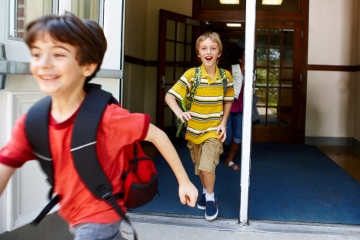- Home
- Loss Control
- Loss Control Insights
- A Guide for Preventing Slip and Fall Accidents in Schools (Updated June 2021)
Imagine, you’re walking through the school hallways, distracted by thoughts of everything you need to do that day. Then it happens—you trip over an uneven surface or stumble down a stairway. We’ve all been there. And slip and fall scenarios like this can lead to unfortunate results, ranging from embarrassment to a very serious injury.
Slips and falls rank among the top three causes of loss for most organizations and are the number one cause of school workplace accidents. They’re also a leading cause of general liability claims.
What Are the Top Causes of Slips and Falls in Schools?
The bulk of slip and fall accidents result from five causes: stairs, ladders, snow and ice, outdoor surfaces and wet surfaces. Outlined below are some preventative tips for each of these top causes.Stairs
The most common causes of stairway falls are distractions, poor lighting, rushing, wearing improper footwear, carrying heavy or bulky items and not using handrails. Follow these tips to help avoid falls on stairways:- Use handrails to stabilize yourself as missing a step when descending a stairway can cause a fall, resulting in serious injury
- Take your time when going up or down stairs
- Carrying bulky loads on stairs is risky, so take multiple, smaller trips
- Do not leave objects on or near the stairs because those objects can create obstacles that are difficult for others to see
Ladders
If you need to retrieve something beyond your reach, you should use a ladder or stepstool rather than improvising with a piece of furniture, such as a desk or a chair. However, ladders can pose their own hazards if used incorrectly. Be sure to take the following steps when using a ladder:- Before stepping on a ladder, inspect it for corrosion or other defects that could make it unstable
- Ensure the ladder has level footing; if another person is present, have him or her hold the ladder steady
- Make sure the ladder has an adequate load rating and height for the specific task
- Never stand on the top rung of a ladder
- Avoid positioning the ladder in a heavy-traffic area where someone could bump into it
Snow and Ice
The majority of outdoor slips and falls occur in late winter when temperatures are warm enough during the day to melt snow, but cold enough in the evening to cause melted snow to refreeze. This presents a dangerous and often hard-to-spot hazard: black ice.Because black ice forms overnight, it’s important to check on walkway conditions early in the morning before pedestrian traffic picks up. If black ice is present, mark the area with cones to alert passersby and treat the walkway with ice melt or traction aids, such as sand or poultry grit.
You can also help reduce winter slips and falls by implementing an inclement weather plan that includes snow removal. Work with your in-house staff or snow-removal contractor to identify a piling area away from walking routes and outline when and how often snow should be removed (we recommend after 1-inch of accumulation). Be sure to clear parking lots and sidewalks before staff members arrive. You should also have maintenance staff monitoring the walking surfaces on school property while encouraging all employees to report icy or slippery spots.
Outdoor Surfaces
Sidewalks and parking lots are two of the most common spots for slip and fall accidents. Changes in sidewalk elevation as small as ¼-inch can cause a person to trip. Inspect parking lots and sidewalks for cracks, potholes and other damage and make necessary repairs as soon as possible. In the meantime, block off the hazard with cones or caution tape.Wet Surfaces
The most critical area for slip and fall prevention in buildings is the first 15-20 feet inside the entrance where water is often tracked in. To help properly absorb moisture from shoes, make sure you have adequate mat coverage. Place scraper mats outside of the building and water-absorbent mats inside each building entrance. Custodians should maintain these mats to ensure they are not a hazard themselves. Replace cracked, displaced or damaged mats as soon as possible.If you notice a spill or pooled water, clean it up immediately or place a caution sign while you report it. However, be sure to remove the sign once the area is dry as signs that are left up for too long tend to be ignored.
How Proper Footwear Can Reduce Slips and Falls
Additionally, worn-down and risky footwear account for 25% of all slip and accidents. Encourage your staff to wear footwear appropriate for the day’s tasks and weather conditions. Safer options include shoes with flat heels, multichannel tread and rubber soles. Avoid raised heels or shoes with leather soles, worn heels or open backs.Learn More About Preventing Slip and Fall Accidents in Schools
Read this prevention guide for tips on how to reduce slips, trips and falls. Plus, our slips, trips and falls topic page offers even more helpful resources.Get in touch
Need help? We’re here for you! Whether you have questions or need personalized assistance, your local office is ready to support you.
Loss Control Insights
Stay informed with the latest news and receive actionable safety tips, all carefully curated by our team of experts.
